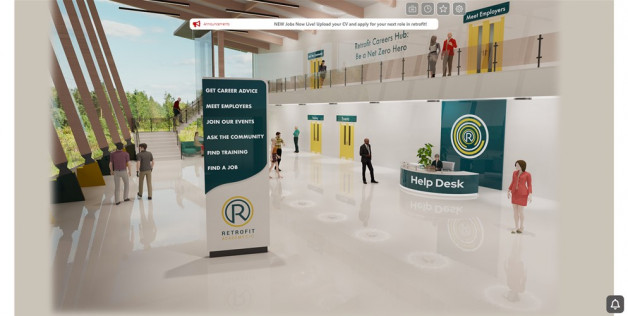As the Government has made over £1.8bn in funding available through the Social Housing Decarbonisation Fund (SHDF) and Home Upgrade Grant (HUG), local authorities, housing associations and their appointed contractors have an opportunity to drive large-scale retrofit forwards. But do they have the skills, knowledge and capacity to deliver these programmes in some challenging timescales?
Work is being done by The Retrofit Academy to address the skills gap to deliver the SHDF and HUG programmes, working closely with local authorities and social housing leaders to identify the conditions for success.
The challenge before us is significant. We do not yet have the workforce needed to decarbonise the 27 million homes we have to retrofit by 2050. But we can put the foundation stones in place now by getting practical about upskilling the existing workforce and attracting new entrants to plug the gaps in these crucial programmes. Here are five labour-force challenges facing large-scale retrofit and potential solutions to address them so programmes can be delivered.
Challenge One: Understanding the capabilities and capacity you will need to deliver at scale
We’ve never decarbonised our housing stock before, so knowing how many people and with what skills we need to deliver that is new territory. Do we need dozens of Retrofit Coordinators? Or thousands? Do we have enough external wall insulation installers or a fraction of what’s required? Will the labour be available when you need it? Or are we all competing for the same workforce?
The starting points for this are the measures you plan to install, the volume of properties you plan to deliver and the availability of labour within your workforce and through contractors. It’s a numbers game. But be warned, there isn’t limitless capacity in the market.
Challenge Two: Building your delivery model around PAS2030/2035
Crucial to the best delivery of high-quality large-scale retrofit programmes is ensuring all work involved is done in line with PAS 2030 and PAS 2035. These standards outline a whole-house approach to the retrofit process that considers condition, what the property is used for, the environment and occupancy. The framework ensures the delivery of quality retrofit at scale, ensuring buy-in from all stakeholders in the process.
Understanding how long each process takes in the retrofitting of each property to achieve the quality outlined by PAS 2030 and PAS 2035, is key. Taking this information about the time it takes combined with the scale of work identified for delivering the programme will give a realistic idea of the timeframe that will be required.
We know that it is only possible for a good standard Retrofit Assessor to undertake 2-3 comprehensive surveys in a day, assuming ease of movement. We also know that every property must be surveyed before a design solution is proposed. It is possible therefore to identify the number of Assessors needed to undertake your programme. The same approach is possible with other PAS 2035 processes and roles.
Challenge Three: Identifying the labour and skills gaps between your existing workforce and what is required to deliver
If we know the measures we want to install and the volume of properties we want to retrofit them to, it is possible to calculate the labour force needed. For example, if we accept that the typical EWI install takes a team of three people eight days (24 days total per property), then a 500-home EWI project is going to take 24 x 500 = 12,000 man-days. If we know our programme start and finish dates, we can therefore calculate how many EWI installers we need. And I wager it’s a lot more than you hoped!
To determine whether we have the capacity, all we need to do is to subtract the available workforce capacity from the required capacity. Of course, we must acknowledge these models' limitations, but they provide a useful guide.
Challenge Four: Upskilling the existing workforce to address net zero
Once a gap is identified in the workforce, there are only two ways to close it. You can recruit fresh talent, or you can train existing staff to step up.
A process called Training Needs Analysis helps to identify the people within an organisation with the potential to take on a Retrofit Assessor, Coordinator or Advisor role can be identified. It is necessary to consider someone’s existing skills and any new skills required to reach the desired skill level and then create a programme of training for that individual to become qualified. It will also need to consider working style preferences, such as whether someone is more inclined towards office working or working on site.
Skilling up the existing workforce can be an affordable and efficient way of developing an existing team to begin an organisation’s retrofit journey.
Challenge Five: Finding and recruiting the workforce you don’t have yet
Once training opportunities have been identified, there will inevitably be a need to gap-fill the roles that can’t be recruited for or trained internally. The Retrofit Academy has enrolled 5,000 learners on its courses and has set the target of training 200,000 retrofitters by 2030. But a crucial step to driving recruitment of this workforce is getting these graduates into the roles that SHDF and HUG-funded programmes require.
To tackle this, The Retrofit Academy has launched a Retrofit Careers Hub where the latest retrofit talent can connect with housing associations, social housing providers, local authorities and contractors. The Hub provides useful tools for prospective retrofitters looking to develop or start their career in retrofit by connecting them with employers and job opportunities and providing networking, knowledge resources and training opportunities. This includes a programme of regular virtual events and online forums to ensure the community of affiliated employers and retrofit professionals can benefit from the expertise offered through The Retrofit Academy’s extended network of specialist partners.
To learn more about how The Retrofit Academy can support your organisation visit the website by clicking here.



